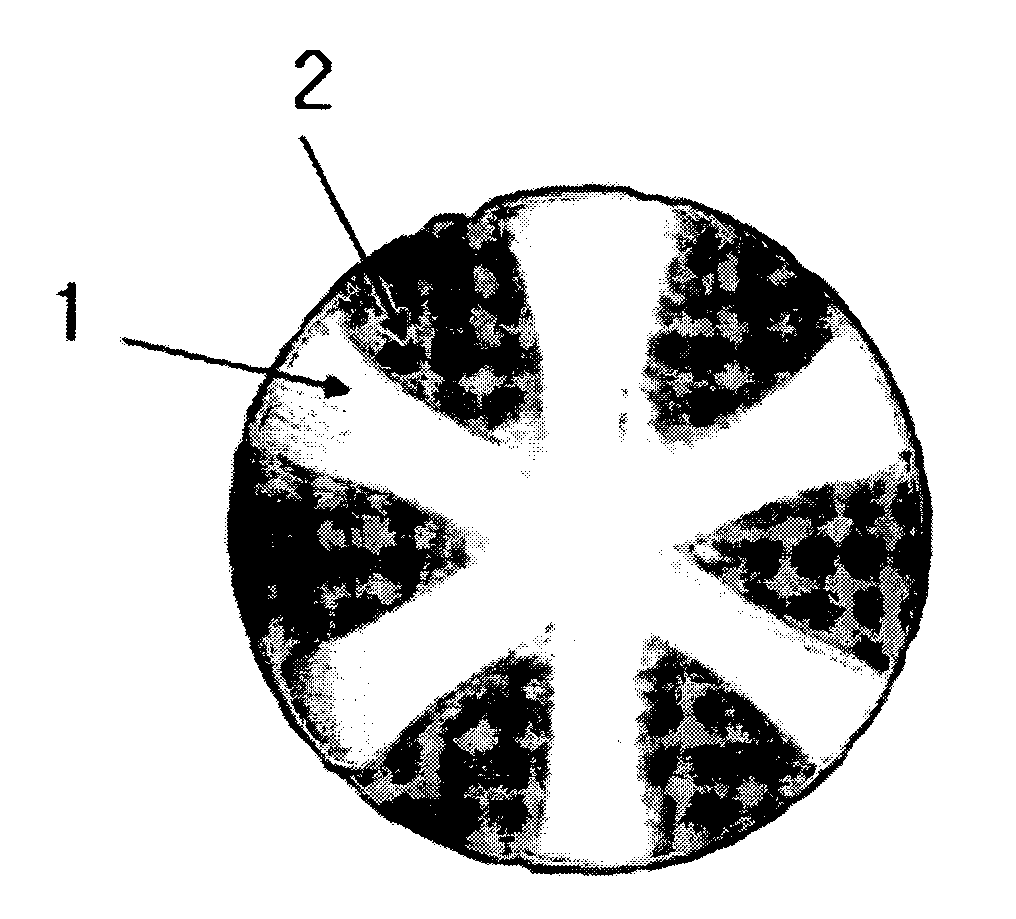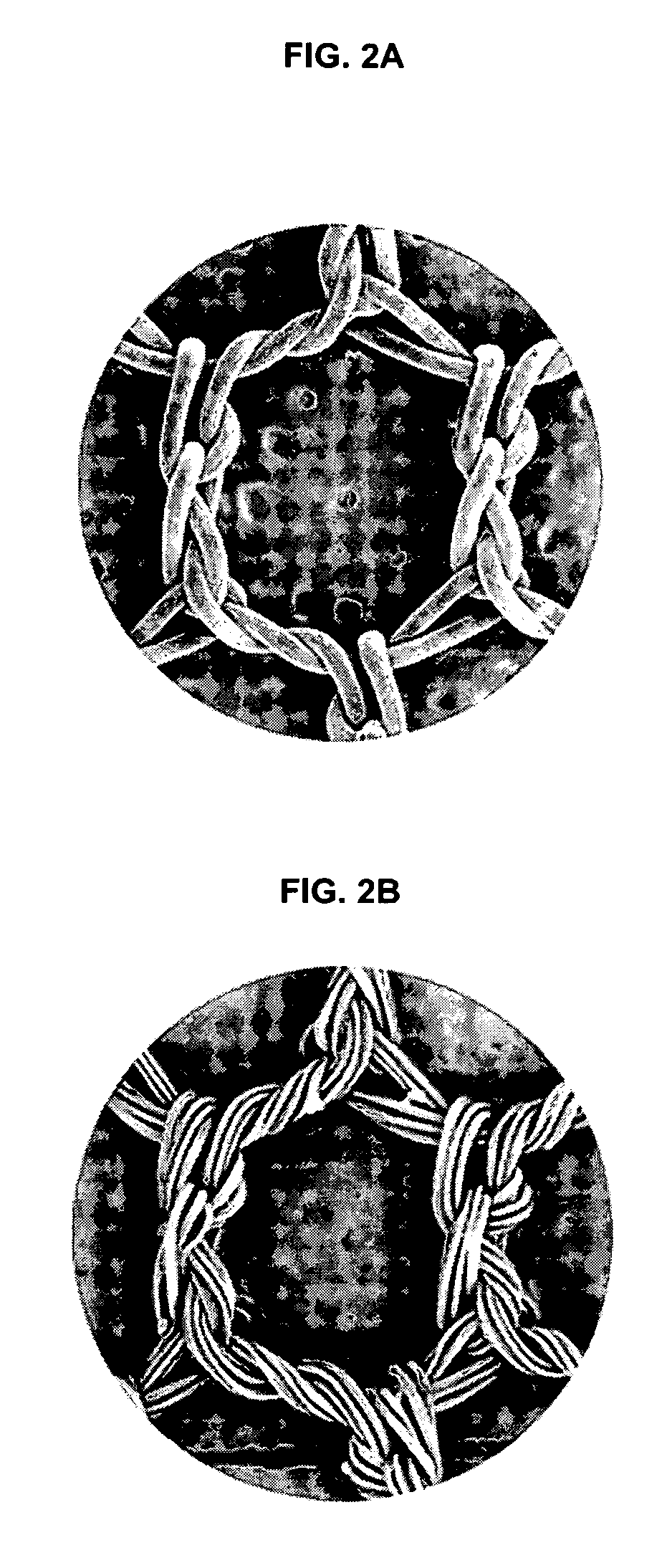Monofilament, Surgical Mesh Having Improved Flexibility and Biocompatibility, and Process for Preparing the Same
a mesh and biocompatibility technology, applied in the field ofmono, can solve the problems of excessive stiffness of the mesh, pain to the patient, and potential fistulas of the intestine of polypropylene mesh, and achieve the effect of improving flexibility and biocompatibility
- Summary
- Abstract
- Description
- Claims
- Application Information
AI Technical Summary
Benefits of technology
Problems solved by technology
Method used
Image
Examples
example 1
[0060] The monofilament in the segmented pie form was prepared through conjugated spinning of 55 vol % of a glycolide (75) / caprolactone (25) copolymer as a degradable polymer and 45 vol % of polypropylene as a non-degradable polymer under the conditions shown in the following Table 1. The prepared monofilament in the segmented pie form was warped with 150 yarns / 7″ beam to prepare the mesh according to the above warp knitted texture of Example 1. The prepared mesh was cured at 150° C. for 5 minutes. The properties of the mesh, such as thickness, weight, tensile strength, and stiffness were determined according to the conventional measuring methods, and the results are shown in the following Table 6.
TABLE 1glycolide (75) / caprolactonePolymerpolypropylene(25) copolymerMelt index (g / 10 min, 230° C.)1013Spinning ConditionsExtruderExt. 1Ext. 2The number of segments of the non-6—degradable polymerPre-pump pressure (kgf / cm2)8080Temperature inZone 1150150Extruder (° C.)Zone 2160165Zone 3170...
example 2
[0061] The monofilament in the segmented pie form was prepared through conjugated spinning of 55 vol % of a glycolide (75) / caprolactone (25) copolymer as a degradable polymer and 45 vol % of a propylene (97) / ethylene (3) copolymer as a non-degradable polymer under the conditions shown in the following Table 2. The prepared monofilament in the segmented pie form was warped with 120 yarns / 7″ beam to prepare the mesh according to the above warp knitted texture of Example 2. The prepared mesh was cured at 155° C. for 3 minutes. The properties of the mesh, such as thickness, weight, tensile strength, and stiffness were determined according to the conventional measuring methods, and the results are shown in the following Table 6.
TABLE 2Propylene (97) / ethylene (3)Glycolide (75) / randomcaprolactone (25)PolymercopolymercopolymerMelt index (g / 10 min, 230° C.)812Spinning ConditionsExtruderExt. 1Ext. 2The number of segments of the non-6—degradable polymerPre-pump pressure (kgf / cm2)8080Temperat...
example 3
[0062] The monofilament in the segmented pie form was prepared through conjugated spinning of 55 vol % of a dioxanone (90) / trimethylenecarbonate (9) / caprolactone (1) tri-block copolymer as a degradable polymer and 45 vol % of polypropylene as a non-degradable polymer under the conditions shown in the following Table 3. The prepared monofilament in the segmented pie form was warped with 120 yarns / 7″ beam to prepare the mesh according to the above warp knitted texture of Example 3. The prepared mesh was cured at 95° C. for 10 minutes. The properties of the mesh, such as thickness, weight, tensile strength, and stiffness were determined according to the conventional measuring methods, and the results are shown in the following Table 6.
TABLE 3Dioxanone (90) / trimethylene-carbonate (9) / caprolactonepoly-(1) tri-blockPolymerpropylenecopolymerMelt index (g / 10 min, 230° C.)1010Spinning ConditionsExtruderExt. 1Ext. 2The number of segments of the non-6—degradable polymerPre-pump pressure (kgf...
PUM
| Property | Measurement | Unit |
|---|---|---|
| diameter | aaaaa | aaaaa |
| thickness | aaaaa | aaaaa |
| pore size | aaaaa | aaaaa |
Abstract
Description
Claims
Application Information
 Login to View More
Login to View More - R&D
- Intellectual Property
- Life Sciences
- Materials
- Tech Scout
- Unparalleled Data Quality
- Higher Quality Content
- 60% Fewer Hallucinations
Browse by: Latest US Patents, China's latest patents, Technical Efficacy Thesaurus, Application Domain, Technology Topic, Popular Technical Reports.
© 2025 PatSnap. All rights reserved.Legal|Privacy policy|Modern Slavery Act Transparency Statement|Sitemap|About US| Contact US: help@patsnap.com



